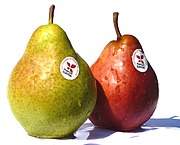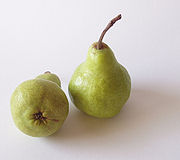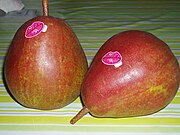Pear
The pear is called the fruit of different species of the genus Pyrus, made up of deciduous trees commonly known as pear trees. However, when it comes to the edible fruit, it is refers mainly to that produced by the so-called common pear tree (Pyrus communis). The pear is a very juicy, fleshy fruit and one of the most important produced in temperate regions.
In China they are considered a symbol of longevity because, although their flowers suggest fragility, they grow on the pear tree, a tree characterized by its strength and longevity capable of withstanding the harshest droughts. The intense character under this apparent fragility is a common characteristic in the flowers and fruits of its family -the Rosaceae-: roses, strawberries, peaches and cherries. In addition, its unmistakable flavor resists distillation to make brandy. The pear is one of the fruits that is best tolerated by the body and the one that produces the least allergies, it has a high water content (more than 80%), making it very easy to digest; It is rich in fiber, vitamin C and has antioxidant properties. Therefore, it is considered very suitable for achieving vitamin enrichment and promoting a healthy and balanced diet.
World production
Source: Pear production, according to the FAO.
Species and Varieties
There are more than thirty varieties of pears, of different colors, textures and flavors. According to their cold requirements to ripen and when they are consumed, they are classified into summer pears (little or no cold requirement to ripen, short storage, consumed in summer) and winter pears (considerable cold requirement to ripen, greater conservation, they are consumed in winter).[citation required]
The main varieties produced worldwide are Bartlett (a summer cultivar) and Beurré d'Anjou (a winter pear cultivar). These two cultivars also have well-known red-skin mutations in the market (for example, 'Red Bartlett' and 'Red Anjou'). Other varieties eaten are 'Packham's Triumph' and its red mutation (winter pear), 'Beurré Bosc' (winter pear), 'Clapp's Favorite' and its mutation 'Red Clapp's' (summer pears), 'Doyenne du Comice' (winter pear), etc.
|
Other species of the genus Pyrus that produce «Pears»
Within the genus Pyrus, the following species that produce "Pears"
- Pyrus pyrifoliawhose fruit is known as nashi, it is also called pear of the sands, or pear Asian.
- Pyrus nivaliswhose fruit is known as pear from the snow.
Other unrelated species producing «Pears»
There are also other species of trees or shrubs that produce fruits that are also commonly called "Pears" due to the similar appearance that its fruits present with respect to the fruits of the genus Pyrus.
Among the similar fruits also called "Pears", we can find:
- Bey's "Pera" (Frutus of the species Citrus × bergamia)
Properties
Very appreciated for its nutritional properties and its delicate flavor. It is recommended in diets due to its low caloric content, about fifty-three calories per hundred grams. It contains vitamins B1, B2 and niacin or B3, all from Complex B, which regulate the nervous system and the digestive system; strengthen the heart muscle; they protect the skin and hair and are essential for growth. It also contains vitamins A and C, is rich in minerals such as calcium, phosphorus, magnesium, copper and potassium, as well as tannins, oleic, palmitic, glutamic, caffeic, linoleic, aspartic, folic and ascorbic acids. Its fiber content improves digestion. It has astringent properties.
In Spain, the pears from Jumilla (Murcia), those from Rincón de Soto (La Rioja) and the pears from Lérida (Catalonia) have designation of origin.
In Argentina, pears are produced especially in the area of the Río Negro Valley, in the province of the same name, along with the production of apples.
Crude pear | |||
| Water: 83.71 g | total remains: 0.33 g | fiber: 3.1 g | energy value: 58 kcal |
| simple sugar: 9,80 g | glows: 15,46 g | protein: 0.38 g | lipids: 0.12 g |
| Oligoelements | |||
| potassium: 119 mg | phosphorus: 11 mg | calcium: 9 mg | magnesium: 7 mg |
| sodium: 1 mg | iron: 170 μg | copper: 82 μg | zinc: 100 μg |
| Vitamins | |||
| vitamin C: 4.2 mg | vitamin B1: 12 μg | vitamin B2: 25 μg | vitamin B3: 157 μg |
| vitamin B5: 48 μg | vitamin B6: 28 μg | vitamin B9: 0 μg | vitamin B12: 0 μg |
| vitamin A: 23 IU | retinol: 0 μg | vitamin E: 0.12 μg | vitamin K: 4.5 μg |
| Fats | |||
| saturated fats: 6 mg | monounsaturated fats: 26 mg | polyunsaturated fats: 29 mg | cholesterol: 0 mg |
Etymology
The name pear comes from the Vulgar Latin pera (plural of the neuter noun pirum- i of the second declension), a word that has been adopted, almost without modification, until our days, in other languages such as English (pear), and its origin was in the West Germanic languages. In some Latin American countries, it is called perejea or kuali ortayumma (which translates as "green testicle"), the way in which the indigenous people look like, from Colombia, call this fruit.[citation needed]
Conservation
For industrial preservation, pears in a fresh state require temperatures close to 0 °C, with relative humidity of 90-95 %, supplemented with controlled atmospheres or other technologies. 1-Methylcyclopropene prolongs high levels of firmness of the fruit, but the pear does not always appropriately resume ripening until it reaches a melting texture, for which reason the application of this technology is in experimentation.
In a cold room, the life of these fruits can be extended between two and seven months, depending on the varieties cultivated. In general, the ones with the shortest duration in postharvest are the so-called “summer pears” ('Clapp's Favourite', 'Bartlett', etc.), while those with the longest duration are the so-called “winter pears” ('Beurré d'Anjou', 'Beurré Bosc', 'Doyenné du Comice', 'Winter Nellis' and 'Packham's Triumph', among others), which require longer, lower temperatures to ripen.
Uses
The main use of the fruit is gastronomy, it is frequently used as dessert fruit and in the canning industry to make compotes such as (pears in wine) and jams. In Europe, the pear is used in the production of perry (perry cider), very popular in Great Britain, particularly in the west and Wales, and in France, especially in Normandy and Anjou.[citation required ]
Contenido relacionado
Gastridium
Crypsis
Arundoclaytonia











